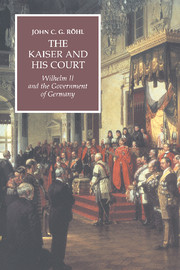Book contents
- Frontmatter
- Dedication
- Content
- Preface to the English edition
- Introduction
- 1 Kaiser Wilhelm II: a suitable case for treatment?
- 2 Philipp Eulenburg, the Kaiser's best friend
- 3 The Kaiser's court
- 4 The ‘kingship mechanism’ in the Kaiserreich
- 5 Higher civil servants in Wilhelmine Germany
- 6 The splendour and impotence of the German diplomatic service
- 7 Dress rehearsal in December: military decision-making in Germany on the eve of the First World War
- 8 Kaiser Wilhelm II and German anti-semitism
- Notes
- Index
8 - Kaiser Wilhelm II and German anti-semitism
Published online by Cambridge University Press: 05 October 2015
- Frontmatter
- Dedication
- Content
- Preface to the English edition
- Introduction
- 1 Kaiser Wilhelm II: a suitable case for treatment?
- 2 Philipp Eulenburg, the Kaiser's best friend
- 3 The Kaiser's court
- 4 The ‘kingship mechanism’ in the Kaiserreich
- 5 Higher civil servants in Wilhelmine Germany
- 6 The splendour and impotence of the German diplomatic service
- 7 Dress rehearsal in December: military decision-making in Germany on the eve of the First World War
- 8 Kaiser Wilhelm II and German anti-semitism
- Notes
- Index
Summary
In 1894, when Kaiser Wilhelm II had been on the throne for only six years and Bismarck in angry retirement for four, when Adolf Hitler was not yet old enough to go to school, an obscene broadsheet costing 30 Pfennigs appeared on the streets of Berlin which, seen from the vantage point of the present day, poses the question of continuity in modern German history about as starkly as it is possible to pose it. Entitled ‘In the 20th Century’, an ornate cartoon (fig. 2) pictures the German capital in the year 1950. It projects two scenarios: either the Germans have defeated the Jewish menace, or the Jews have taken over Berlin.
In the latter case, Rothschild rules over Germany, the anti-semites – Böckel, Foerster, Dühring, Schönerer, Stoecker, etc. – are in prison and Ahlwardt is being beheaded. The German people is enslaved in a socialist ‘German Workers' Colony’ run for the benefit of Jewish profiteers. Opposite the colony, beyond the statue commemorating the Liberal parliamentarian Heinrich Rickert, we see the flourishing stock exchange, the Jewish National Theatre and the Jewish National Museum, whereas the Christian Church is being closed down. Germans are being expelled from their own country, their ‘fresh’ young children sold along with geese for Jewish kitchens. Everywhere, Jewish ‘world supremacy temples’ in the form of kiosks are being erected to mark their domination over the ‘German slavenation’.
An altogether different world reveals itself as we raise our eyes to the higher section of the picture. In 1950, Kaiser Wilhelm the Third and his empress have just come to the throne. German artisans and peasants march happily through the streets shouting ‘Heil!’ and ‘Gott mit uns!’ German athletes compete in German Games; the people stream into the Deutsches Volks-Haus to celebrate the glories of Beethoven, Mozart, Goethe and Schiller; German children listen once more to German fairy tales. The Church is back at the centre of society; a statue depicts St George slaying the Jewish dragon. The canonical laws discriminating against Jews have been reinstated, the synagogue has been closed and the Rabbi has committed suicide.
- Type
- Chapter
- Information
- The Kaiser and his CourtWilhelm II and the Government of Germany, pp. 190 - 212Publisher: Cambridge University PressPrint publication year: 1994



